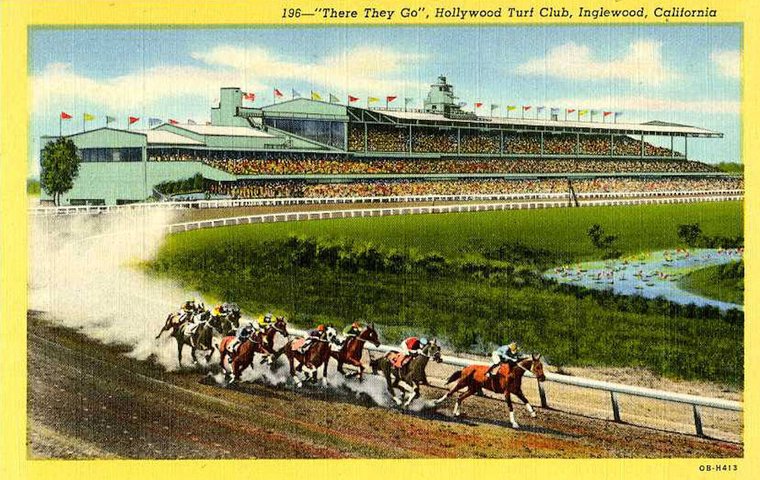
In the second of her unmissable new series, Rachel Pagones recalls the ‘amazing history’ of one of American racing’s foremost venues, which had the distinction of hosting the inaugural Breeders’ Cup in 1984
Hollywood Park was already an anomaly in the 1970s and 80s, but it was not an anachronism. Not yet.
It was an anomaly because it was 260 acres of stables, long considered one of the best training grounds in America – and pens holding horses, goats, and chickens, plus a meticulously maintained racing oval surrounding green grass and little blue lakes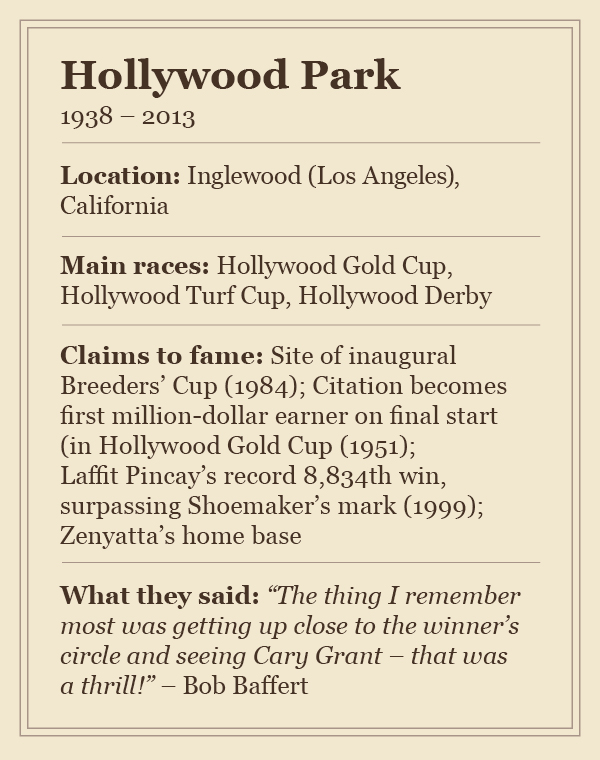 , all in the middle of a giant asphalt parking lot situated near a tangle of freeway onramps and offramps in one of the grittiest, citiest parts of LA.
, all in the middle of a giant asphalt parking lot situated near a tangle of freeway onramps and offramps in one of the grittiest, citiest parts of LA.
By the mid-80s, parts of Century Boulevard, the palm-lined pathway to the races, were patrolled by more prostitutes than police. Yet Hollywood Park still had the cachet – and the chutzpah – to entice racing’s crème de la crème to a newly formed all-star event: the Breeders’ Cup.
Hollywood Park’s founders might easily have envisioned such a gala coming to their racetrack. From Seabiscuit and Citation to Affimed and John Henry, Hollywood Park’s status as one of the nation’s premier racing venues had stood for nearly 50 years.
That intervening half-century, however, had seen much change – and Los Angeles in particular is not a place always steeped in sepia-toned nostalgia.
A racetrack of their own
Hollywood Park opened on June 10, 1938. Just over a month later, the first running of the track’s signature event, the $50,000 Hollywood Gold Cup, was won by the celebrated Seabiscuit, as renowned as any movie star. Indeed, footage of his victory was used in the 1938 film Stablemates, starring Wallace Beery and Mickey Rooney.
Despite its name, Hollywood Park was built in Inglewood in the South Bay region of LA County, ten miles from what would become the famed Tinseltown of popular movie lore. The distance may not have represented much at the time; but it was a span that would come to seem more pronounced as Los Angeles grew and changed.
Hollywood was the third Thoroughbred racetrack to open in southern California, after Santa Anita in 1934 (located in the LA suburb of Arcadia) and Del Mar (in San Diego’s North County) in 1937. All had connections to the Hollywood film industry.
But at Hollywood Park there was a difference. Most the names closely associated with the new racetrack had something in common: they were Jewish. Some of these studio bigwigs had owned and run horses at the other tracks, or at least attended the races in the days when racing was a major social event.
Which was not to say they were entirely welcome. “For the American Jews who were prospering in early Hollywood, Santa Anita was not an Arcadia they could fully access,” writes Josh Kun in an essay in Michele Asselin’s book, Clubhouse Turn: The Twilight of Hollywood Park Racetrack, alluding to both Santa Anita’s location and the utopic Arcadia of Greek mythology.
Kun, a MacArthur fellow and professor at the University of Southern California Annenberg School of Communication, describes Hollywood Park as “a racetrack of their own”, asserting: “Just as the discriminatory policies of the Los Angeles Country Club led Jewish Angelenos to create the Hillcrest Country Club, so did Santa Anita lead to Hollywood Park – where Jews were royalty, where the periphery became the center.”
Starstruck opening day
It rained on Hollywood Park’s inaugural opening day – improbably, because this was California and it was June. As a result, many women changed their dress from white to safer colors, and Mrs Jock Whitney appeared in cerise and black, the Los Angeles Times reported.
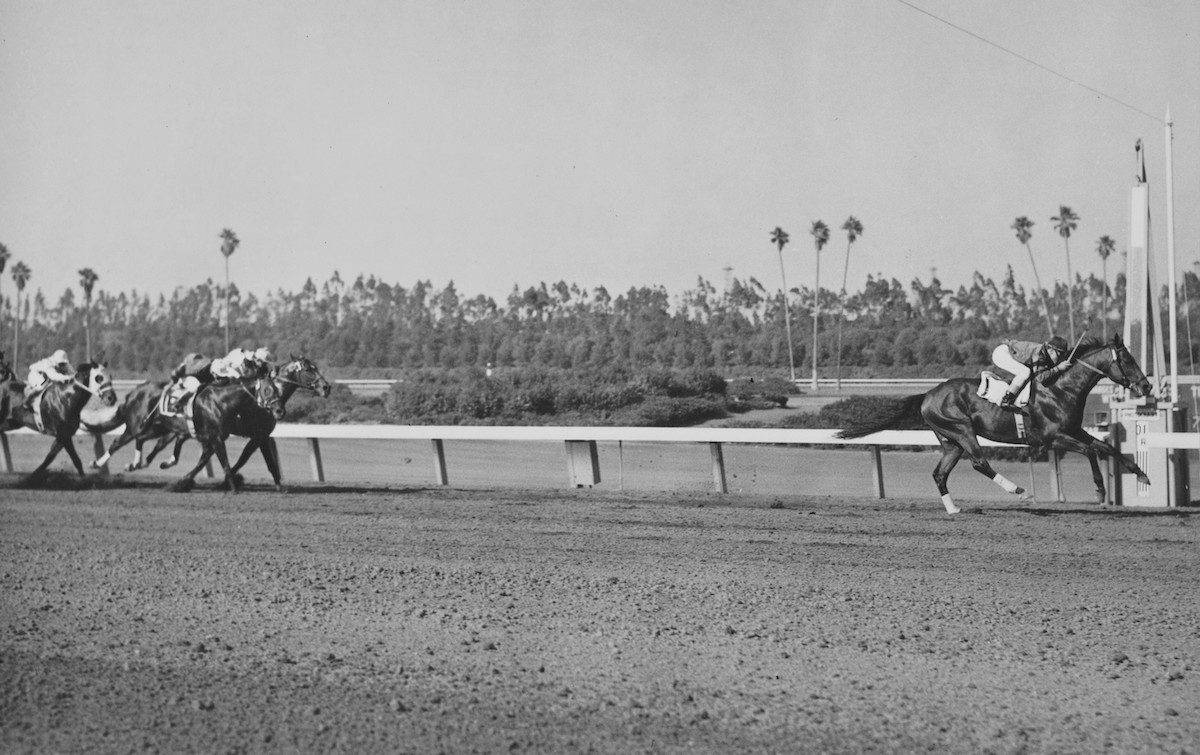 But the crowds – an estimated 40,000 – were swell and everything seemed colorful as Lawrin, the recent Kentucky Derby winner, paraded past. The movie personalities were legion, including Mary Astor, Milton Berle, George Burns and Gracie Allen, Eddie Cantor, Harry Cohn, Claudette Colbert, Joan Crawford, Rita Gable, Al Joplin, Myron Selznick, and Barbara Stanwyck among the throng. On hand to greet them was Jack L. Warner of Warner Brothers Pictures, chairman of the board of the new racing association.
But the crowds – an estimated 40,000 – were swell and everything seemed colorful as Lawrin, the recent Kentucky Derby winner, paraded past. The movie personalities were legion, including Mary Astor, Milton Berle, George Burns and Gracie Allen, Eddie Cantor, Harry Cohn, Claudette Colbert, Joan Crawford, Rita Gable, Al Joplin, Myron Selznick, and Barbara Stanwyck among the throng. On hand to greet them was Jack L. Warner of Warner Brothers Pictures, chairman of the board of the new racing association.
In the early decades, numerous of this Hollywood set were notable owners and breeders. MGM head Louis B. Mayer, for one, ran a powerful stable and campaigned Busher, the 1945 Horse of the Year and the first filly to win the Hollywood Derby.
Meanwhile, after Seabiscuit a litany of top-class horses filled the Hollywood Gold Cup’s roll of honor. They included Triple Crown winners Citation (1951) and Affirmed (1979); Swaps, Round Table, and Gallant Man, all under Bill Shoemaker in the 1950s; Native Diver, three times, in the 1960s; and the 1990s superstars Cigar and Skip Away. In the new millennium, fan favorite Lava Man – snatched by trainer Doug O’Neill from the claiming ranks at Del Mar in 2004 – won three consecutive Gold Cups, the only horse since Native Diver to do so.
The fun was seriously interrupted twice in the 1940s: first, with four years of cancelled or curtailed meets as a result of World War II, and again in 1949 when the much-admired streamlined grandstand was consumed by a massive fire (and the meet moved to Santa Anita, where a teenaged Bill Shoemaker appeared on the LA scene).
Laffit Pincay and a golden era
There was a long time when Laffit Pincay Jr’s name was almost synonymous with Hollywood Park. Pincay’s rise began in a golden time for racing across the US, when Secretariat’s blinkered profile graced the cover of Time Magazine as the first of three Triple Crown winners in the 1970s.
The talent pool of both horses and jockeys at the southern California tracks was deep, with Bill Shoemaker leading the way – but at Hollywood Park it was Pincay who had an award named after him, Pincay who had a street bordering the racetrack renamed in his honor.
Much of Pincay’s era – he first rode at Hollywood Park in 1968 – coincided with that of Marje Everett, who became chairperson of Hollywood Park in 1972 and was CEO from 1985 to 1991. Everett ruled the track with an infamously iron hand, and had a fearsome reputation among employees and racing industry executives alike. But even Everett was fond of Pincay; he considered her “a good, good friend.”
The 1970s was the best era at Hollywood Park “for sure,” avows Pincay now. “There was this unbelievable colony of riders,”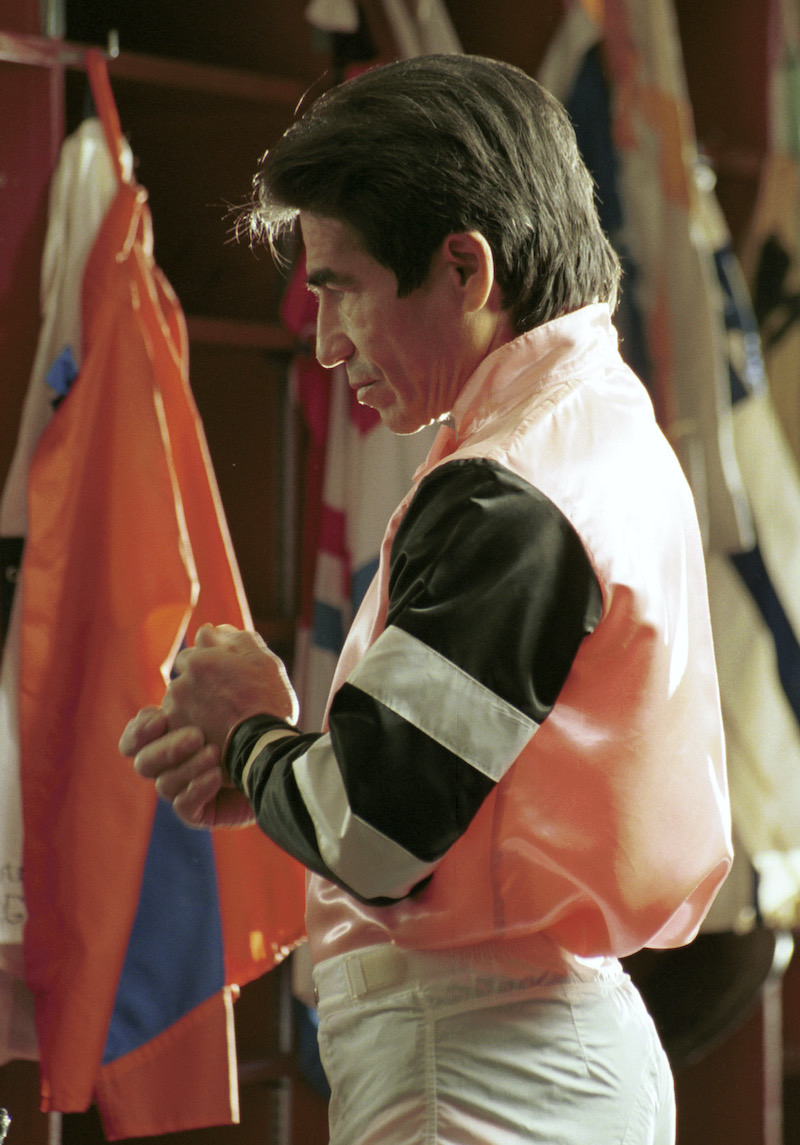 he says. “They were all great riders, a lot of Hall of Famers … I tell you, it was tough. Any of these riders could be leading rider there, any one of them could beat you in a moment.”
he says. “They were all great riders, a lot of Hall of Famers … I tell you, it was tough. Any of these riders could be leading rider there, any one of them could beat you in a moment.”
Still, Pincay landed 16 riding titles at Hollywood Park – more than at any other racetrack. The Panamanian-born jockey made a near-immediate impression when winning six races on April 27, 1968 – ironically on a day dubbed “Willie Shoemaker Day” to honor the injured Shoe, the only other rider to pocket six races on a single card at the track.
It remains one of Pincay’s best moments. His sixth win came via a dramatic late run on Poleax in the Will Rogers Handicap. “When I came back, people were standing up, giving me a standing ovation because the only one who could do that was Bill Shoemaker,” he recalls. “So I got there and I did it and it was great. I’ll never forget that ovation that they gave me.”
He also took the Hollywood Gold Cup nine times. Among Pincay’s Gold Cup winners were Perrault and Greinton in the 1980s, both British-breds trained by Charlie Whittingham.
The ‘Bald Eagle’, as the conditioner was known, was another overwhelmingly dominant force in the 70s and beyond at Hollywood Park, winning every Gold Cup from 1971-1974 and another in 1978 (four of the five with Shoemaker). Whittingham’s final Gold Cup win would come in 1987 with the tough-as-nails Ferdinand, again under the Shoe.
Big crowds and big quality
The crowds in this era were commensurate with the quality of racing. On July 3, 1977, Seattle Slew came to Hollywood Park, fresh from his Triple Crown victory, to contest the G1 Swaps Stakes before an audience of 68,000. Madeleine Auerbach, now a leading California owner-breeder and racing industry executive, was there with her young family. “We went with the kids and it was a mob scene and it was very difficult to park the car, very difficult to get in,” she says.
Her husband bought $2 win tickets for each, with instructions to keep them as souvenirs. “Well we couldn’t have cashed them,” says Auerbach, “because J.O. Tobin came like a steamroller. I’ll never forget that.
“You talk about a stadium going completely quiet. The wild cheering for Seattle Slew – and J.O. Tobin beating him – the place was like a tomb after that.”
The 16-length defeat, by Britain’s top-rated two-year-old of 1976 – ridden by Shoemaker – was the first in Seattle Slew’s lifetime.
‘Whatever vice you wanted’
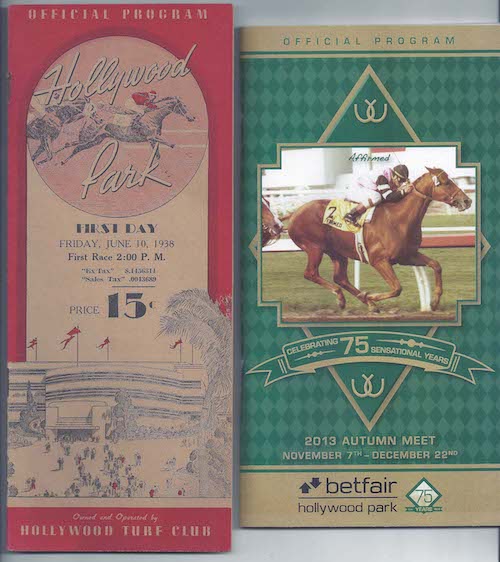 The packed grandstands for the Swaps bore evidence that within Hollywood Park’s grounds, the cinematic enchantment of an earlier era held. Outside them, Inglewood was changing.
The packed grandstands for the Swaps bore evidence that within Hollywood Park’s grounds, the cinematic enchantment of an earlier era held. Outside them, Inglewood was changing.
Auerbach, who is today a US Jockey Club member and founder of the racehorse charity CARMA, began going racing with her husband, Jim, in the 1970s. Jim enjoyed gambling and she found that she did, too. Eventually they got into racing and breeding.
Sitting in their box near the finish line, the couple were surrounded by “mostly everyday Joes. For big races it was a lot of different people but for the day-in-day-out guys they were the gamblers”.
The way into the track, however, represented another world. “At every single stop light, particularly for Friday night racing, there would be three or four prostitutes that would come to the car and proposition us,” recalls Auerbach.
Jerry Murphy, an assistant trainer to Charlie Whittingham in the 1970s, remembers the blandishments of Century Boulevard, the main road leading from nearby LAX airport and the major LA freeways to Hollywood Park. “You could get whatever vice you wanted right on that street,” he says, going on to describe the area surrounding the track.
“Outside the gate it was very rough back then,” says Murphy. “There was a little doughnut shop across the street … you had to push through a bunch of hookers at 4.30am or 5am in the morning when you were trying to get in. It was pretty wild.”
Bright young thing: the first Breeders’ Cup
Wild it might have been outside the gates, but in 1984, the Breeders’ Cup came to town. Marje Everett pitched hard for the inaugural event of seven G1 races worth a total of $10m to go to Hollywood Park. As often happened, she won her battle – in this case after contributing $200,000 of her own money to the bid.
The move brought widespread charges of unethical behavior, and did nothing to warm the chilly relationship between Everett and Santa Anita officials – but it forever stamped the name Hollywood Park in the annals of Breeders’ Cup history.
In the event, few complained about that first event. The lunches may have been overpriced, but the racing was magnificent, capped by what still ranks among the most exciting Breeders’ Cup Classic finishes.
The first-ever Breeders’ Cup race was the Juvenile won by Chief’s Crown, bred by Carl Rosen from his mare Six Crowns, so-named as the daughter of two ‘triple crown’ winners in Secretariat and Chris Evert.
The day also marked a memorable success for the young up-and-coming Englishman John Gosden – then based at Hollywood Park – who saddled former Michael Stoute-trained Royal Heroine to win the Mile for leading European owner Robert Sangster. And the Aga Khan’s Lashkari won the Turf – at 53-1 – under the legendary Yves Saint-Martin to ensure serious international recognition.
The Classic was a tale of rogues and outsiders. One – Gate Dancer – was a determined non-conformist sporting an outlandish set of headgear; the other, Wild Again, represented a brash roll of the dice for his owners and trainer. Their chief rival was the sleek Slew o’ Gold, a son of Seattle Slew and the hot favorite for the race.
Wild Again, under Pat Day, took an early lead through sharp fractions, with Slew o’ Gold, Angel Cordero aboard, coming from midfield to tackle him with half a mile to run. Next-to-last at this point, Gate Dancer and Laffit Pincay began roaring up the outside. The three pulled away from the field in a furiously contested stretch drive, Slew o’ Gold pinched and buffeted between horses.
Wild Again’s dark head was just in front of Gate Dancer’s masked visage at the wire – but the latter was disqualified for interference, and placed third behind Slew o’ Gold.
It was a bitter end to the day for Pincay, who thought he was on the winner at the head of the stretch. “He was moving very, very fast,” says Pincay. But then his mount’s quirkiness kicked in. “He started to lug in. And I couldn’t really ride him that much, because I felt some bumping.”
Some commentators felt that Wild Again’s number should have been taken down as well. Pincay concurs, but adds, “Those things happen in racing.”
The times they are a-changin’
Hollywood Park would host two more Breeders’ Cups. The first was in 1987, with Francois Boutin, Freddy Head and the great filly Miesque teaming up to win the Mile, and 74-year-old Charlie Whittingham, 56-year-old Bill Shoemaker, and four-year-old Ferdinand narrowly defeating Kentucky Derby and Preakness winner Alysheba in the Classic.
The second, in 1997, featured among others the quixotic Elmhurst, a one-time French campaigner who made his first (and only) G1 appearance – in the Sprint – a surprisingly victorious one for trainer Jenine Sahadi and jockey Corey Nakatani; and the endearing combination of Skip Away (under Mike Smith) and trainer Sonny Hine duly taking the Classic by six lengths.
However, the interim between the two festivals saw significant events at the track and in surrounding Inglewood.
In some small measure the Hollywood in Hollywood Park held on, through one persistent vehicle at least: a boat shaped like a swan, carrying a lovely young lady across the infield’s lakes, sometimes trailed by waterfowl. The Goose Girl, as she was known, was present at the track on opening day in 1938, wandering about the infield in her yellow silk dress and carrying a shepherd’s crook.
Such was her allure that Laffit Pincay, asked about his most memorable moments at the track, cited before anything else his first sight of the Goose Girl on his first day of riding at Hollywood Park in 1968. For Pincay, as for others, she was part and parcel of the movie-set fantasy that included meeting actual Hollywood stars.
The Goose Girl joined the queue of those fired by Marje Everett in the 1970s, although the women’s liberation movement may have been the primary motivator for that dismissal. But she was revived by R.D. Hubbard in 1991, the year he finally managed to oust Everett as chairperson of the board and CEO.
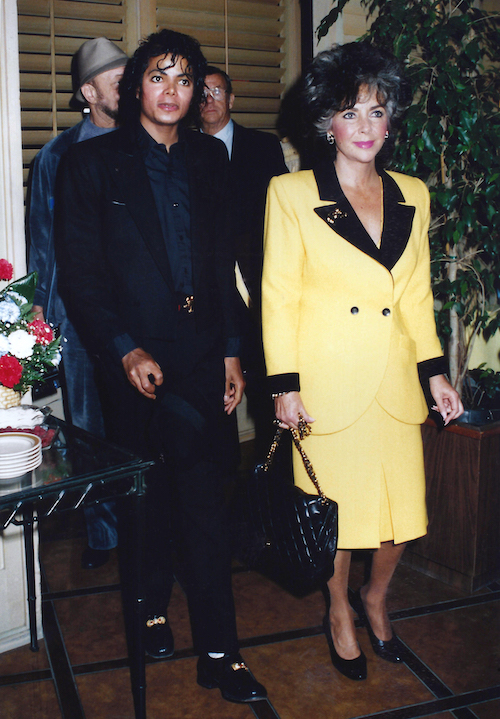 Everett’s tenure had been stormy, but her accomplishments were notable. Among them were introducing Sunday racing in 1973, Pick Six wagering in 1980, and Friday night racing in 1988. Her socializing skills drew celebrities including Burt Bacharach, Cary Grant, John Forsythe, Michael Jackson and Elizabeth Taylor to the track.
Everett’s tenure had been stormy, but her accomplishments were notable. Among them were introducing Sunday racing in 1973, Pick Six wagering in 1980, and Friday night racing in 1988. Her socializing skills drew celebrities including Burt Bacharach, Cary Grant, John Forsythe, Michael Jackson and Elizabeth Taylor to the track.
Hollywood Park had run into financial straits coinciding with the advent of off-track betting and the California state lottery in the 1980s. Hubbard splashed out big, with $20m in improvements in 1991. In 1994, another $20m was spent on the Hollywood Park-Casino, a games and simulcast facility adjacent to and physically dominating the racetrack.
Outside the grounds, violence sometimes took the stage. In April 1992, simmering rage broke through after four police officers were acquitted at trial of charges pertaining to the brutal beating of Rodney King, an unarmed Black man, which was caught on video.
Los Angeles erupted into rioting in the days following the verdicts. In Inglewood, as elsewhere, fires burned, buildings were smashed, businesses looted. More than 50 people were killed.
Sports events were called off across the city, and Hollywood Park cancelled racing. On the other side of the country, mint juleps were downed as the Kentucky Derby prepared to take place.
Los Angeles Times sportswriter Mike Downey wondered longingly when LA would return to its routine self. Lamenting the uncertainty of rescheduled events, he said they were “not impertinent questions, these. They come under the heading of the most pertinent question of all: When will we get back to normal?
In hindsight, it seems the old normal was unacceptable. And things, as ever, were changing.
The long goodbye
Hollywood Park hosted its third and final Breeders’ Cup in 1997, with the crowd of 51,161 significantly smaller than that in 1984, but significantly larger than any in the previous decade.
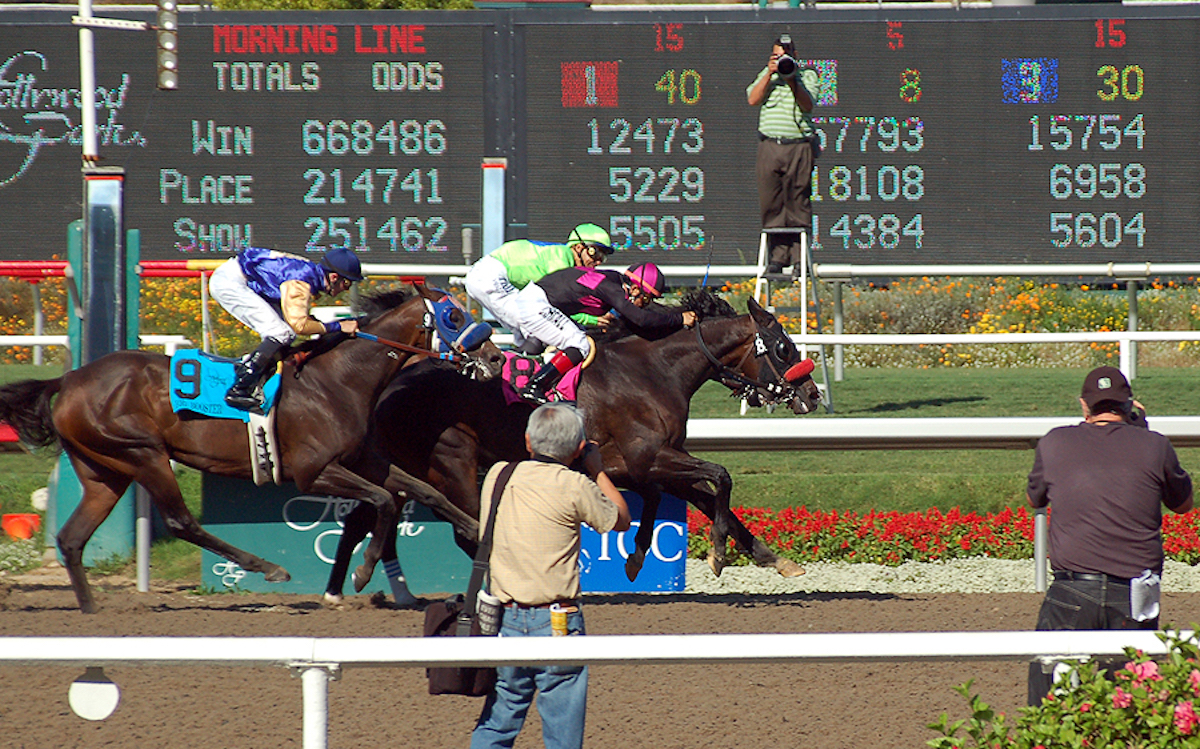 There were other highlights: Laffit Pincay finally exceeded Shoemaker’s record of lifetime wins with his 8,834th victory in 1999. Cesario became the first Japan-bred and -trained horse in 46 years to win a US stakes race – the American Oaks Invitational in 2005 – and Zenyatta burst on the scene with eight of her 19 wins at Hollywood Park during the track's Cushion Track synthetic era.
There were other highlights: Laffit Pincay finally exceeded Shoemaker’s record of lifetime wins with his 8,834th victory in 1999. Cesario became the first Japan-bred and -trained horse in 46 years to win a US stakes race – the American Oaks Invitational in 2005 – and Zenyatta burst on the scene with eight of her 19 wins at Hollywood Park during the track's Cushion Track synthetic era.
The track’s later years often felt like a series of mergers and acquisitions, however. Ownership of Hollywood Park went from Churchill Downs, Inc., in 1999 to the Bay Meadows Land Company in 2005.
In 2012, the Hollywood Park Racing Association forged an agreement with Betfair US under which the track became known as Betfair Hollywood Park – and thus it remained until the following year, when Jack Leibau, president since 2005, announced its closure.
There was quality to the last; the tenth race on the final card on December 22, 2013, went to the California-bred California Chrome, the subsequent Kentucky Derby, Preakness Stakes, and Dubai World Cup winner.
Attendance at live racing had fallen off the charts in recent years, though. The land upon which Hollywood Park sat was now tremendously valuable as a site for other, more popular pastimes. Its crowning feature today is SoFi Stadium, home to the Los Angeles Chargers and Los Angeles Rams, and site of this year’s Super Bowl LVI.
Some of those present for the track’s glory days are surprisingly pragmatic about the cause, even as they feel sorrow about the decision.
“It is very sad but it's worth more as real estate – it’s as simple as that,” John Gosden told the Racing Post when Hollywood Park closed, adding: “That track just has an amazing history. So many great horses ran there. You just have to look down the list of winners of the Hollywood Gold Cup, for example. It's just phenomenal.”
Noting that Inglewood was becoming more upscale even before the racetrack’s closure, Madeleine Auerbach says, “Everything changed, the whole landscape. Politically and economically and every way you can think of, it was an anachronism by the time they closed it up.”
Of SoFi Stadium and other developments replacing one-third of southern California’s once-thriving prestige circuit, she says, “Was it good for racing? No. Was it good for the southern California and Los Angeles economy? Yes, very.”
Laffit Pincay echoes that sentiment. Acknowledging that Hollywood Park’s demise is a loss he feels personally, he says: “But I guess it was business. Racing has decayed a lot in California.”
He adds, however: “It’s sad to me – when I go to Santa Anita I don’t see that many people there. And I’m afraid that something in the future could happen to Santa Anita. And I hope not, because racing is beautiful.”
Great racetracks we have lost: Rockingham Park – the ‘little Saratoga’ of New England
Breeders' Cup pre-entries set up Flightline vs Life Is Good clash
Why Tyler’s Tribe is about so much more than the Breeders’ Cup
View the latest TRC Global Rankings for horses / jockeys / trainers / sires


